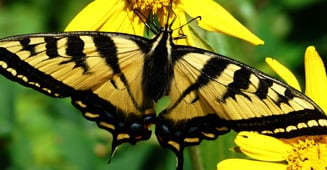

Contributor
- Topics: Archive

1. Plant native flowering plants in a sunny area. Cluster native flowers in a variety of colors and shapes that bloom throughout the
growing season.
2. Don’t forget to include caterpillar host plants. Many butterfly caterpillars are entirely dependent on one specific host plant; providing proper host plants is critical.
3. Place basking rocks in sunny areas. Butterflies perch on stones, spread their wings, and soak up the sun to raise their body temperature.
4. Provide wind shelter. Shrubs, fences, and hedgerows create inviting microclimates that will attract butterflies to flutter, nectar,
bask, mate, and lay their eggs.
5. Encourage “puddling.” Many butterflies drink and get important trace minerals from small puddles; provide a shallow dish filled with damp sand or mud.
6. Leave wild patches and overwintering sites. Caterpillars and pupae will find overwintering and pupation sites in your leaf litter, mulch, woodpile, and tall grasses. Pruning, weeding, and tidying should be done lightly, seasonally, and with extreme care.
7. Build fertile, well-drained soil. Healthy soil is the foundation of a healthy garden ecosystem.
8. No pesticides—ever! Pesticides and herbicides are toxic to butterflies and other beneficial insects in all life-cycle phases. Encourage natural pest control.
Resources:
The Lifecycles of Butterflies, Judy Burris and Wayne Richards, Storey Publishing, 2006.
North American Butterfly Association, www.nababutterfly.com
“Butterflies and How to Attract Them” Washington Department of Fish & Wildlife
Nancy Seiler, 2010, “Attracting Pollinators to your Garden using Native Plants” (FACT SHEET)
Washington Butterfly Association
More information
- Connor, E., Hafernik, J., Levy, J., Moore, V., & Rickman, J. (2003). Insect Conservation in an Urban Biodiversity Hotspot: The San Francisco Bay Area. Journal of Insect Conservation 6 p. 247-259
- Levy, J. M., & Connor, E. F. (2004). Are gardens effective in butterfly conservation? A case study with the pipevine swallowtail, Battus philenor. Journal Of Insect Conservation, 8(4), 323-330.
- Matteson, K., & Langellotto, G. (2010). Determinates of inner city butterfly and bee species richness. Urban Ecosystems










Responses